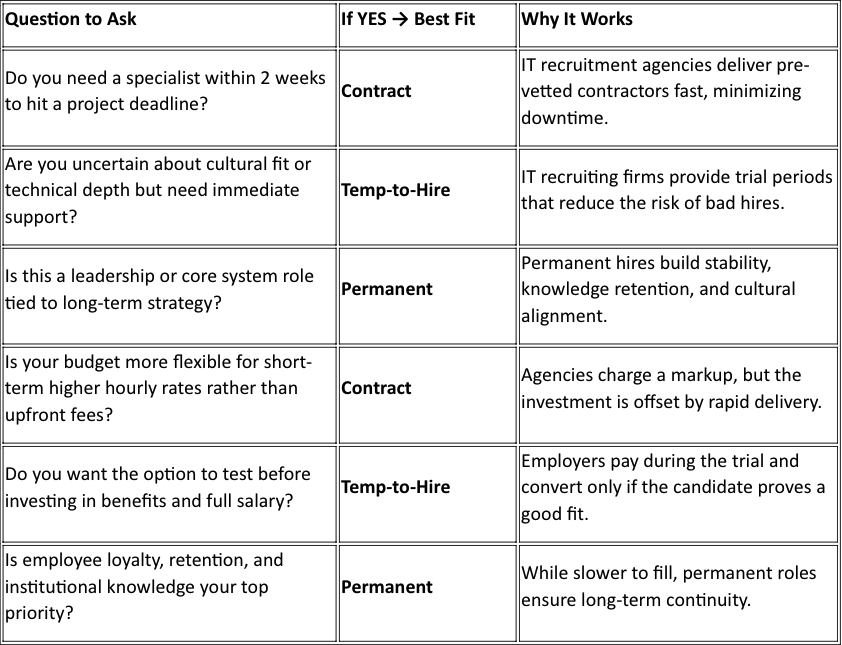Inside the current IT landscape, where projects move in sprints and specialized skills are in short supply, choosing the wrong hiring model slows delivery and inflates costs. Temporary and contract talent now play a material role in the workforce: recent government and industry data show millions of contingent workers and millions more placed through staffing firms each year, underscoring how mainstream these models have become. In this blog, we cut through the jargon and give IT leaders a practical framework, with data, timelines, and a quick decision checklist, so you are able to choose whether to bring in contract experts for speed, use temp-to-hire to vet long-term fits, or commit to permanent hires for mission-critical roles.
Prevalence & Growth of Contingent/Temporary Work
In recent years, contingent and temporary work arrangements have moved from fringe staffing strategies to core components of workforce planning. Analyses of the contingent workforce market in 2024 show that staffing agencies continue to play an essential role. For instance, the report by AllWork found that the U.S. temporary staffing workforce declined slightly from 2.8 million in 2023 to about 2.6 million in 2024, a drop of ~8%. Nonetheless, although the absolute numbers have shifted, the need for flexible hiring via staffed temporary positions remains strong, especially in sectors such as IT, where projects often require niche skills that are not needed permanently. Therefore, IT recruitment, especially by IT recruitment agencies and IT recruiting firms, is increasingly tapping contingent models to meet skill gaps and short-term demands.
Furthermore, data highlights that 64% of employers planned to increase their reliance on contract professionals in 2024, signaling an upward trend in using temporary or contingent staffing. Rather than being a temporary shift, contingent work appears to be building sustained momentum across industries. Given this growth, it becomes clear that understanding contingent staffing is no longer optional; it’s a foundational piece of strategy for anyone involved in IT recruitment or working with an IT recruitment agency. Accordingly, the next question is: how do speed, cost, and the trade-offs compare when choosing contract vs temp-to-hire vs permanent staffing models?
Time-to-Fill & Speed vs Permanence Trade-off
When organizations weigh contract, temp-to-hire, or permanent staffing, speed of placement is often the first deciding factor. In IT recruitment, where project deadlines and security updates don’t wait, the difference between filling a role in two weeks or in six determines whether critical objectives are met.
Industry benchmarks show that contract and temporary roles are typically filled much faster than permanent ones. For example, The State of Talent Acquisition in 2025 indicates that many contract placements in technology average two to three weeks, while permanent roles stretch closer to 30–45 days. An IT recruitment agency accelerates this process by maintaining curated talent pools, often presenting pre-screened candidates within days. This agility is one reason IT recruiting firms are increasingly relied upon for high-urgency projects like cloud migrations or cybersecurity compliance.
However, the advantage in speed often comes with different fee structures. Contract hires typically involve hourly billing plus an agency markup, which means higher per-hour costs but lower upfront expenses. In contrast, permanent placements usually require a one-time recruitment fee, commonly 15–25% of the candidate’s annual salary, paid to the IT recruitment agency. Temp-to-hire sits in between: while companies pay for the contractor during the trial period, a conversion fee applies if the professional transitions into a permanent role.
Moreover, IT recruiting firms manage hidden time costs that are often underestimated. These include candidate sourcing, background checks, skills testing, and onboarding coordination, all tasks that extend timelines if handled internally. By outsourcing to an IT recruitment agency, companies trade a placement fee for a significantly reduced time-to-fill, freeing internal teams to focus on operations rather than prolonged search cycles. Yet, for strategic positions tied to culture, leadership, or core product ownership, the longer process of permanent staffing is worth the wait. Although more time-consuming, a carefully vetted permanent hire reduces long-term turnover, saving costs over multiple fiscal years and aligning better with enterprise-wide IT strategy.
In short, IT recruiting firms help companies balance the trade-off between speed and permanence by tailoring fee models and candidate pipelines to specific business needs. With that balance in mind, the next step is to evaluate temp-to-hire staffing, which blends rapid onboarding with the opportunity to assess long-term cultural fit before making a final commitment.
Temp-to-Hire Models: Conversion, Retention, and Risk Mitigation
Among the three staffing models, temp-to-hire is often considered the most balanced. It allows companies to bring in professionals quickly, while still leaving room to evaluate technical skills and cultural alignment before making a permanent commitment. In IT recruitment, this approach is especially valuable for roles that combine highly specialized knowledge with long-term team collaboration.
Recent industry findings show why temp-to-hire continues to gain traction. Data shows that nearly 60% of employers used temporary placements as a direct pipeline for permanent hires in 2024. Similarly, staffing benchmarks highlight that conversion rates from temporary to permanent employment often fall between 40% and 60%, depending on the sector. This means that almost half of temporary workers evaluated by employers through IT recruiting firms eventually transition into full-time employees, making temp-to-hire both a risk-reduction strategy and a recruitment funnel.
From a cost perspective, IT recruitment agencies structure temp-to-hire agreements differently from either contract or permanent models. Employers typically pay the hourly or project-based rate during the trial period, with a conversion fee only if the professional is retained permanently. While this fee equals a percentage of the candidate’s annual salary, the ability to test skills and team fit before paying reduces the risk of a costly mis-hire. For IT recruitment, where technical mismatches delay entire projects, this “try-before-you-buy” setup is often a safeguard worth the investment.
Moreover, IT recruiting firms play a crucial role in mitigating risks during the evaluation phase. They manage performance check-ins, provide feedback loops between employer and candidate, and ensure compliance with worker classification. This oversight reduces legal and operational risks while giving both sides time to determine whether a permanent partnership makes sense. Consequently, temp-to-hire staffing provides a middle path: faster access to talent than a traditional permanent hire, with significantly less risk than relying solely on short-term contracts. Having explored all three models: contract, temp-to-hire, and permanent, the final step is to consolidate these insights into a clear decision framework so IT leaders select the right staffing solution with confidence.
Decision Checklist: Choosing the Right IT Staffing Model
Now that we’ve explored contract, temp-to-hire, and permanent staffing, the next step is translating insights into action. This checklist helps IT leaders, HR managers, and business owners quickly determine which option aligns best with their goals.
By using this decision framework, companies align their staffing choices with both immediate operational demands and long-term business goals. In the end, no single staffing model is universally the “best” option, it depends on your timeline, budget, and long-term goals. Contract staffing delivers speed, temp-to-hire reduces risk, and permanent hires secure stability. What matters is having a trusted partner who understands the nuances of IT recruitment and adapts the model to your specific needs.
At Coastal Management Solutions, we specialize in helping organizations navigate these choices with clarity and precision. As an experienced IT recruitment agency, we connect you with top talent through flexible models, whether you need contract experts, a temp-to-hire pipeline, or strategic permanent placements. By working with Coastal, you gain access to IT recruiting firms’ best practices without the complexity, ensuring your projects stay on track and your teams grow stronger. Contact us today for a tailored consultation and discover how we turn your hiring challenges into long-term success.
About Coastal Management Solutions
Coastal Management Solutions, Inc. is a woman-owned and operated company specializing in comprehensive Government, IT, Engineering and Professional Services staffing solutions. Our recruiting experts excel in sourcing and placing candidates with unique skills tailored to your organization’s or project’s requirements. With over 60 years of combined experience in government contracting, commercial staffing, and engineering, we are well-equipped to meet your staffing needs.



